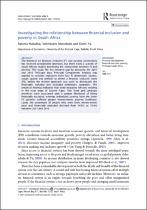| dc.contributor.author | Ratema, Mahalika | |
| dc.contributor.author | Matsebula, Velenkosini | |
| dc.contributor.author | Yu, Derek | |
| dc.date.accessioned | 2022-05-25T10:29:30Z | |
| dc.date.available | 2022-05-25T10:29:30Z | |
| dc.date.issued | 2021 | |
| dc.identifier.citation | Mahalika, R., Matsebula, V., & Yu, D. (2021). Investigating the relationship between financial inclusion and poverty in south africa. Development Southern Africa, doi:10.1080/0376835X.2021.1978933 | en_US |
| dc.identifier.uri | https://doi.org/10.1080/0376835X.2021.1978933 | |
| dc.identifier.uri | http://hdl.handle.net/10566/7459 | |
| dc.description.abstract | The literature on financial inclusion (FI) and poverty connections has received considerable attention, but there exists a scarcity of South African studies examining the relationship between FI and poverty. This study fills this research gap by analysing the 2011 and 2016 FinScope data. Principal Components Analysis was applied to consider indicators from four FI dimensions (access, usage, quality and welfare) to derive a financial inclusion index (FII), before the relative approach was used to distinguish the financially included and excluded individuals separately. The empirical findings indicated that lowly educated Africans residing in the rural areas of Eastern Cape, Free State and Limpopo provinces were associated with a greater likelihood of being financially excluded, whereas individuals coming from the lower FII quintiles suffered greater money-metric poverty likelihood. Lastly, the proportion of people who were both money-metric poor and financially excluded declined from 19.5% to 15.4% between 2011 and 2016. | en_US |
| dc.language.iso | en | en_US |
| dc.publisher | Routledge | en_US |
| dc.subject | Financial development | en_US |
| dc.subject | financial inclusion | en_US |
| dc.subject | Poverty | en_US |
| dc.subject | FinScope South Africa | en_US |
| dc.title | Investigating the relationship between financial inclusion and poverty in South Africa | en_US |
| dc.type | Article | en_US |

